| |
Interview

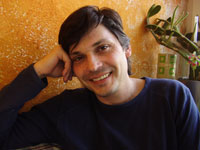 INTERVIEW WITH JAROM VOJTEKOM, INTERVIEW WITH JAROM VOJTEKOM,
The film s scriptwriter, director and director of photography
How did you find the village Slemence and the sad story of its people?
While I was studying at the Academy of Music and Dramatic Arts, I also made friends with actors, because at that time we were all together at Ventúrska Street. Well, one day I was drinking with Tibor Tóth, an acting student, in the well-known café Depreso, and he started to tell me the story of the small village he lived in, which, 60 years ago, had been divided into two parts; half in Ukraine and half in Slovakia. As a young boy, he had always dreamed of driving through the whole village on his bicycle, but it wasn’t possible. I thought that maybe we had drunk too much, but when I later visited Slemence, I found out, that, unfortunately, he was right ….So I became strongly interested in this village, and concurrently with the shooting of “We Are Here”, in 2001 I also started shooting The Border.
At the beginning of the shooting, what was your concept of the film? Did it change in any way during the shooting?
Initially, it was a major challenge for me – how to capture the theme, how to look at the border. For a long time I kept going to Slemence, just to talk to the people, trying to find something that could be the starting point. The stories I collected about the border were already part of the past, and the film still seemed too static to me. I did not want to tell the story of the border through different, artificial and visually constructed situations. I found it very made-up, and, to me, what’s most important are films built upon authentic situations, which “breathe” by being lifelike and human. I think I have chosen the more difficult and complicated path, but to seize something, which touched you with the power of a non-repeatable, authentic feeling and to feel as though you had lived through all that together with those people, makes it a unique challenge for me. So I succeeded in finding characters, whose lives have been strongly influenced by the artificially constructed border. And I started capturing their destinies. And my concept of the film changed along with the changes in their destinies over the course of the shooting. I took a risk by recording their stories along with the changing situation at the border. My concept has been fulfilled, and I hope that viewers will also find something in it for themselves. Because I believe that the more intimate and personal my concept of the film is, the more universal and open I am. The question, however, is, how broad will the range of viewers I reach be, because during the shooting I do not think about the viewers, but I am rather “resolving myself”. Then it makes me even happier, if my films appeal to someone. I am not saying that I did not apply the essential communication elements in the film. My point is to draw in and surprise the viewers, I do not want them to suspect or anticipate the ending. I want them to be stunned, not to remain indifferent. I want the cathartic feeling last event when they leave the theatre… I don’t only want to give them what they ask for, I want to give them something in addition, which they did not anticipate … To let them learn a lot about me through my film, to learn how I see the world and things surrounding me.
What message did you want to send to the viewers with The Border?
I wanted to reflect on the absurdity of creating any borders, and about how helpless man alone is, even now, against the power decisions made by the state or pursuing higher interests. Where is the man – the identity, with unrepeatable and unique stories of his life today? What is an individual, in today’s world that embodies the mass? A lonely man against the environment he lives in. Decisions about his life may be made somewhere else and he has no influence. I also wanted to reflect on the absurdity of our deeds and actions. To offer a look at ourselves in order to make us capable of self-reflection and realizing the loss of our simple values, which are extremely important to our lives – otherwise we feel lost. Values such as love, submission, tolerance, attentiveness to each other, modesty, fairness, openness, straightness, friendship, virtue … It is a kind of a self-portrait of issues, which I am concerned about, and through shooting I endeavor to learn as much as possible about these issues. In fact this is the reason for my filmmaking – because unrepeatable, authentic people marked by the irony of life are books you cannot buy anywhere …
How long did it take to make the film?
The shooting started in 2001. At that time I captured the first happenings at the border and in the village. I waited for different events in the village, and after I had the baseline of the individual stories established, I only continued following the real daily occurrences in their lives. In this way I recorded the village life as well as the destinies of its people for seven years.
You finished recording the destinies of the people of Slemence in 2007. Has your interest in the village continued? Are you in any contact with the main characters of the film?
Unfortunately, only with some of them… This little village is on the Ukrainian border, and that is about a 1,000 km roundtrip. So traveling there is very time-demanding. But sometimes I call Tibor Tóth… and, in particular, now I am involved with other film characters, which requires me to kind of fine-tune myself to a different feeling.
Why do you prefer the time-collecting method of shooting?
The long-term collection of material, for me, means to be as close to the truth as possible. However, sometimes it can also be a great risk, which actually was the case with “Here We Are” and the “Border”, because I did not know how the story would end. It cost me a lot of nerves, and now I prefer going into more certain things. For example, I recently started shooting the Roma Sendrei, who is going into politics, and will run in the elections. Well, it will turn out somehow… But it is also related to the fact, that when you observe a certain environment for a long time, or a person, it will show you different forms, more plastic, more dramatic, you become familiar with it and see it more personally, just like you see your friends and other people around you in your real life. This means more intimately, and that is what I really enjoy.
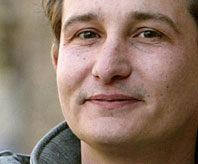 INTERVIEW WITH MAREKOM LEŠČÁKOM, INTERVIEW WITH MAREKOM LEŠČÁKOM,
the film s scriptwriter and script editor
What made you a “child of feature films” interested in a documentary?
In fact I have been making them since I graduated, concurrently with feature films. What fascinates me in this work is the active contact with reality, which helps me also in my work on feature films. Paradoxically, the last two films I made (Here We Are and Blind Loves), move within a border zone between a documentary and a feature. Anyway, in principle I think that regardless of whether it is a documentary or a feature, what’s most important, is the theme of the film. The choice between a feature, a documentary or something in between is only about choosing a suitable method for sizing the theme…
What was the most interesting for you as script editor and co-author during the production of The Border?
The mere fact that there is a village in our territory artificially divided by a border reminiscent, in its own way, of the Eastern and Western Berlin, was fascinating for me. The most important task was to find a balance between the historical facts, i.e. drawing a map of almost 50 years from the time the village was divided, and the living present, namely the efforts of the local people to open the gates, associated with other themes such as unemployment, smuggling etc. which are represented in the film in the stories of real people.
Why the time-collecting method?
The time collecting method came up naturally from the process of becoming familiar with the environment on both the Slovak and Ukrainian side of the border and the endeavors of the people to open a border checkpoint. The individual characters gradually unfolded and we tried to capture their stories in such a way that led to a natural end, stemming from their real lives. That actually happened after opening the border crossing point between the two parts of the divided village. Paradoxically, till the time the border crossing was opened, all old relations between the families were broken, and smugglers and marketeers were more delighted by the opening of the border checkpoint than the local people.
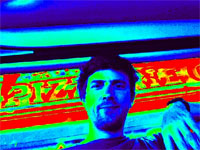 INTERVIEW WITH TOMÁŠOM STANEKOM, INTERVIEW WITH TOMÁŠOM STANEKOM,
The film’s director of photography
What do you enjoy about a documentary?
I enjoy the continual change ... the theme develops, many times “on the run”, new people, situations … I also enjoy dealing with real-life situations, most likely I would never ever come across those people and their stories without shooting documentaries. Being the director of photography, working on a documentary gives me a greater freedom, I like reacting to new stimuli, as well as to unforeseeable situations, many times I have to react quickly, and this was even more difficult during the shooting of the Border, as I don’t speak the language (Hungarian).
I doubtlessly enjoy working on a documentary also because I can cooperate with great directors - strong personalities.
Do you mind the longwinded way of working?
No, quite the opposite is true. I enjoy going back to the same places and following the changes. It is always good to return to the same place after a long time and to see everything from a distance.
What was the difference between working on the Border and on a feature film? A great difference – just the mere fact, that we worked on the Border for several years, and a feature can be produced in a month or two…or three.
Have you already learned Hungarian?
Not yet, the only world I learned was "borzasztó" – which means “terrible”....
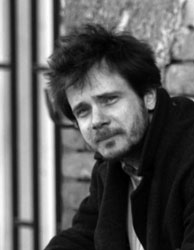 INTERVIEW WITH MAROŠOM ŠLAPETOM, INTERVIEW WITH MAROŠOM ŠLAPETOM,
The film’s editor
What is the basic difference in the approach to a feature and to a documentary theme?
From the editor’s point of view, there is in fact no particular difference between editing a feature film or a documentary. The editor has to do his best to make, from the entire material available, a story that works. And this applies equally to documentaries as well as features. Perhaps, documentaries require even more work than feature films.
Why did you agree to work on a documentary and what does a documentary mean to you?
What is interesting in working on a documentary is that the editor’s satisfaction from the final result can be even greater. As well as his freedom ... There is almost nothing at the beginning, but the idea ... the story, which finally results in a film! Editing a documentary, the editor often finds himself in the position of a co-scriptwriter, in consideration of the fact, that no script in the real sense of the word exists. But this is certainly compensated by a huge quantity of work. Many times it is also related to the quantity of the shot material. And there are really huge quantities shot, in most cases using the time-collecting method. And it always takes time. But I certainly would not want to focus solely on documentaries. Surely, real life is often too sad and cruel. And, one day I would also like to produce a joyful film... most likely not a documentary. And besides: people love illusions, people even need them. But if a documentary is good, it should make no difference in the movie, whether you watch a documentary or a feature, the point is that it must be good.
What made your work on the Border interesting or difficult?
I don’t event remember exactly, when we started working on this project. Over those years we became overwhelmed by huge quantities of shot material. Hours and hours of interviews made with people living in Slemence. Of course most of them in Hungarian... And we – I and Jaro Vojtek with Marek Leščák, we only sat sadly in the editing room and did not understand a word... until Zuzana Cséplő, an editor, joined us. I suppose we would never have been able to complete it without her... I think the language barrier was really the most difficult part of working on this film.
This film is also interesting for the fact, that its main character is the environment – the village itself. I tried to include as much as possible of that atmosphere into the film. And I managed - also thanks to our excellent photographer Tomáš Stanek The time-collecting was also very exciting. We ourselves followed with excitement, how the situation developed in Slemence. Will they open a border crossing or not … In addition to the historical developments, the time also offered us the possibility to follow the development of the private stories of our film characters. I think that also for this reason we succeeded in producing a film, which captures a certain period in history, but at the same time it is timeless in that it tells the story of human destinies. For me, personally, this film is a very strong story which carries a universal message.
While working on this film, several times I experienced my own personal catharsis - first when I completed the editing of the service version, when the entire story unfolded in front of my eyes, and later after the final color corrections, when I almost physically realized the visual quality of the film. The next catharsis arrived after mixing the film with the composed music. I am very glad that the atmosphere and the life within this film’s environment are as close to real as can be. Thus, there is nothing else left for me but to compliment all our colleagues: in addition to Jaro Vojtek, scriptwriter Marek Leščák also those, who are sometimes forgotten: director of photography Tomáš Stanek, film-editor Zuzana Cséplő, composer Peter Groll and sound engineer Marek Lacena.
Have you learned Hungarian yet? :-)
I haven’t learned Hungarian yet, despite the fact, that since our cooperation on the Border, I have participated in the production of another film with Hungarian dialogues. But this time it was a feature film. But at least I’ve slowly been building up my vocabulary. I can say: munkás (a worker) and kedves gyerekek (dear children)!
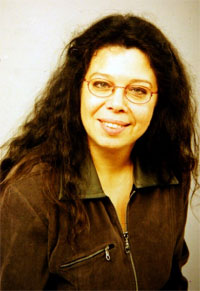 INTERVIEW WITH ZUZANOU CSÉPLÖ, INTERVIEW WITH ZUZANOU CSÉPLÖ,
The Film’s Editor
What do you think about the fact that a Slovak made a film about Hungarians living on the Slovak-Ukrainian border? :-)
Well, did that Slovak know at all about those Hungarians, or did he learn about them only on site, and, as a true documentary maker, he “found a trace”, forgot about the nationality and the human stories grabbed hold of him and didn’t let him go :-)
What do you prefer editing a feature film or a documentary?
A feature or a documentary? Well...I prefer “a good film” most :-) the one with a strong story. The most exciting for me is the process of “creation” – how the pile of shot material turns into a story. The bonus to this magic is the wishing, wise and receptive fellow-fighters! / And, let’s have a beer after useful “arguments” :-)
What was the reason for making this film?
Unfortunately it turned out that meaningless borders (and not only those made of barbed wire) are being created even today, in the 21st century, although it looked so promising at the beginning of the shooting.
What was most difficult and most humorous during work on the Border?
Laborious but necessary: to select the material. Difficult but necessary: to shorten the story, say goodbye to some characters. Bizarre: to edit the Hungarian text through a telephone, as the guys in the editing room did not speak a word in HungarianJ. Phenomenal: a four-hand editing... it really works! /but only with such an amazing co-player!!!/ Witty, but unbelievable: how the director and the director of photography disputed, during the shooting, with the respondent whether he had said what they wanted him to say, they wanted him to explain, even though they did not speak Hungarian /?/ and the respondent did not speak Slovak.
/Well, Jarko, how was it with the fast-track course of Hungarian? ...katicabogárka? (Ladybird/ :-)
By the way, thank you for the scarce opportunity to work with you! It was enriching! |